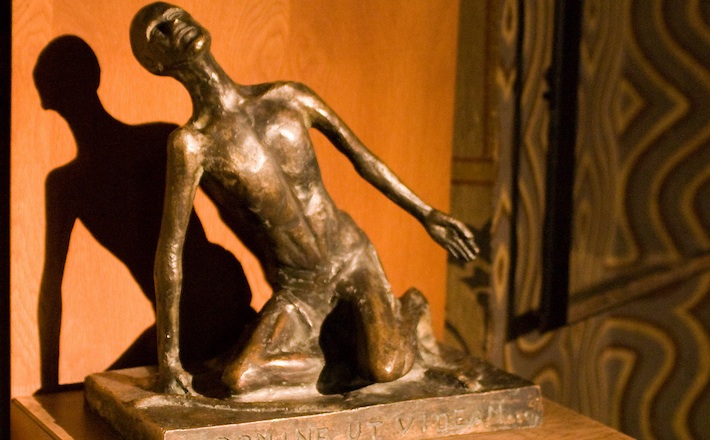Commentary on Hebrews 7:23-28
The author of Hebrews has a tendency to circle back around to content he has discussed before, but I find his manner neither repetitive nor laborious.
Not only would audiences listening to the text need to hear it several times to understand and remember it, but moreover he presents each repetition in a slightly different manner. The end of chapter 7 is a perfect example of this phenomenon. Here the author compares the priesthood of Jesus Christ with other priests just as he had done in 4:14-5:10, but in this instance the author focuses upon Christ’s superiority in the multiple dimensions of Christ’s perfection.
Priesthood 1.0
The author first asserts the Biblically unique idea of Jesus’ priesthood in Hebrews 2:17. In chapter 4-5, he shows how Christ resembles but also excels other priests. One key difference is the priestly order to which they belong. Jesus, through God’s calling, serves as a priest in the order of Melchizedek (5:10). The author has much to say about this topic (5:11), but in order to do so, he has to jolt his audience to attention with a severe exhortation and an equally powerful encouragement. He doubts they are ready to process such high level teaching (5:1-12); they might even be in danger of regressing to the point of falling away (6:4-8). Importantly, however, they have not crossed this line and so they must hold on to the hope they have in Christ.
At the beginning of Hebrews 7, then, the author can take up his teaching on Melchizedek. Ingenious and therefore its nuances highly debated, most scholars nevertheless would agree that the author of Hebrews utilizes the Old Testament stories about Melchizedek to show that there has existed an alternative and superior priestly order at least since the time of Abraham and more likely, since time eternal. If that is the case, then he can, without fear, articulate the failings of the Levitical priesthood, namely its inability to bring perfection and subsequent proximity to God (7:18-19).
Priesthood 2.0
The latter section of Hebrews 7 names those failings. First, the Levitical system has many priests involved. His point here seems not to be the many priests who serve throughout the temple, but the succession of High Priests. His point could be an example of the ancient preference for the “one” over the “many” or it could be more focused upon the reason for the succession of priests, namely that they all die. Jesus, in contrast, remains forever. Because God said so in his oath (“you are priest forever”) and because Jesus has defeated death (2:14; 5:7-9), he will never succumb to mortality. Consequently, his priesthood will be an unchanging one. Two issues are intimately related here: Jesus’ is a priesthood of life and therefore it is a consistent and trustworthy priesthood. If a contemporary Jewish audience would bemoan the flux in the history of the Jewish priesthood, an irreplaceable, trustworthy, and benevolent priest would be a welcome and powerful repose.
Salvation Then
Hebrews 7:25 moves the idea of his priesthood into the realm of application. Jesus’ living and eternal priesthood offers salvation. For the author salvation indicates rescue from death (5:7) — which Jesus has already experienced — but which is still future for the audience (1:14; 9:28). In case the audience did not fully understand, the author reiterates that this salvation from death is eternal. Not a prolonged life or a resuscitation, but life forever. Where else would life eternal reside than in the presence of God? What the Levitical priesthood could not achieve, that is access to the true presence of God in heaven, Jesus’ priesthood allows.
One reason that Jesus the High Priest can offer this eternal salvation is that he can focus his priestly work on intercession because he has already taken care of the problem of sin. Other priests are daily occupied with sin removal (Hebrews 7:27). Moreover, they can’t even devote their attention solely to the people they serve for they must also be concerned with the removal of their own sin. Jesus has taken care of all that. He has made one fully efficient sacrifice for sin and it never has to be repeated (see also 10:18). That offering was himself (a topic to which the author will return in 9:11-14 and 10:5-15).
Salvation Now
Salvation entails even more, though. Participating in the hope of salvation in the future indicates that they participate in it in the present in some way (Hebrews 6:9). Along the path to God’s presence, Jesus, the eternally abiding priest, intercedes for his people. There will never be a period of newness or transition with this priest. The one who knows them intimately (2:14) and sympathizes with them (4:14) will always be there vibrantly alive to aid them on their journey to the place where he now resides, in the very presence of God.
What a privileged place they hold! The author says that it was fitting for them to have such a High Priest who has been exalted even above the heavens. Why are they so important as to warrant an undefiled priest? It is because they are part of the group that is looking forward to inheriting salvation (Hebrews 1:14). If God determined to save forever his people, God provided such a priest to make this salvation available.
In the last verse of Hebrews 7 the author includes another tight comparison between Jesus and the other priests. The law appointed them, a law that had to do with genealogical descent (7:14). The law does not stand apart from God, but it certainly is not as direct as God’s oath concerning the priesthood spoken to Christ directly. Moreover, this oath has chronological superiority. It came after the law, which for our author indicates that God brought one system to an end and, though long planned, instituted a new one. Finally, the primary difference is what was instituted: men who were weak verses a Son who, though beset with the same weakness, moved through it to the point of perfection.
The author has prepared the ground for his next application. This priest will bring to fruition the long awaited hope for a New Covenant. From his vantage point as One living in the presence of the living God, he can affect a heart change that will allow humans to draw near to God as well. That is a priesthood worth discussing, over and over and over again.


October 25, 2015